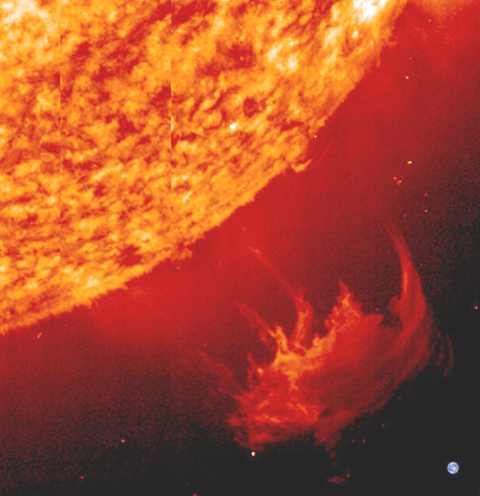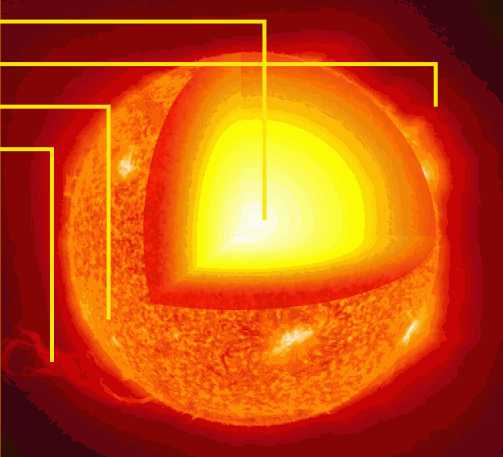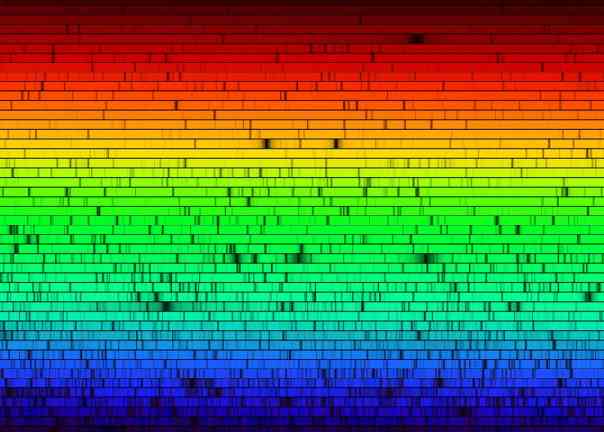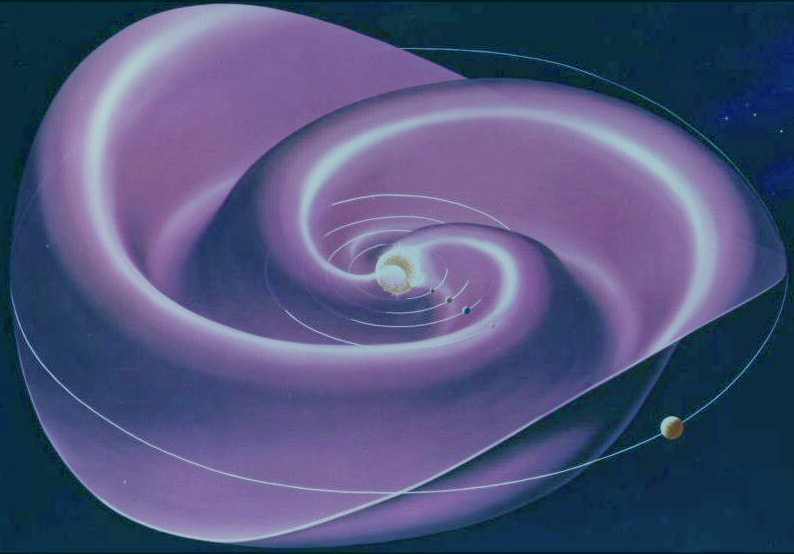|
THE SUN
|
|||||||||||||||||||||||||||||||||||||||||||||||||||||||||||||||||||||||||||||||||||||||
|
HOME | BIOLOGY | BOOKS | FILMS | GEOGRAPHY | HISTORY | INDEX | INVESTORS | MUSIC | NEWS | SOLAR BOATS | SPORT |
|||||||||||||||||||||||||||||||||||||||||||||||||||||||||||||||||||||||||||||||||||||||
|
The Sun (or Sol) is the star at the center of our Solar system. Earth orbits the Sun, as do many other bodies, including other planets, asteroids, meteoroids, comets and dust. Its heat and light support almost all life on Earth.
The Sun is a ball of plasma with a mass of about 2×1030 kg, which is somewhat higher than that of an average star. About 74% of its mass is hydrogen, with 25% helium and the rest made up of trace quantities of heavier elements. It is thought that the Sun is about 5 billion years old, and is about halfway through its main sequence evolution, during which nuclear fusion reactions in its core fuse hydrogen into helium. In about 5 billion years time the Sun will become a white dwarf.
Although it is the nearest star to Earth and has been intensively studied by scientists, many questions about the Sun remain unanswered, such as why its outer atmosphere has a temperature of over 106 K when its visible surface (the photosphere) has a temperature of just 6,000 K.
The Sun's radius is about 110 times that of the Earth
The diameter of the Sun is 1,400,000 km (840,000 miles) which is more than 100 times the diameter of the Earth. Its mass is more than 300,000 times that of the Earth.
General information
The Sun is classified as a main sequence star, which means it is in a state of "hydrostatic balance", neither contracting nor expanding, and is generating its energy through nuclear fusion of hydrogen nuclei into helium. The Sun has a spectral class of G2V, with the G2 meaning that its color is yellow and its spectrum contains spectral lines of ionized and neutral metals as well as very weak hydrogen lines, and the V signifying that it, like most stars, is a "dwarf" star on the main sequence.
The Sun has a predicted main sequence lifetime of about 10 billion years. Its current age is thought to be about 4.5 billion years, a figure which is determined using computer models of stellar evolution, and nucleocosmochronology. The Sun orbits the center of the Milky Way galaxy at a distance of about 25,000 to 28,000 light-years from the galactic centre, completing one revolution in about 226 million years. The orbital speed is 217 km/s, equivalent to one light year every 1400 years, and one AU every 8 days.
The astronomical symbol for the Sun is a circle with a point at its centre.
The sun as it appears through a camera lens from the surface of Earth
Structure
The Sun is a near-perfect sphere, with an oblateness estimated at about 9 millionths, which means the polar diameter differs from the equatorial by about 10 km. This is because the centrifugal effect of the Sun's slow rotation is 18 million times weaker than its surface gravity (at the equator). Tidal effects from the planets do not significantly affect the shape of the Sun, although the Sun itself orbits the center of mass of the solar system, which is offset from the Sun's center mostly because of the large mass of Jupiter. The mass of the Sun is so comparatively great that the center of mass of the solar system is generally within the bounds of the Sun itself.
The Sun does not have a definite boundary as rocky planets do, as the density of its gases drops off following an approximately exponential relationship with distance from the centre of the Sun. Nevertheless, the Sun has well defined interior structure, described below. The Sun's radius is measured from centre to the edges of the photosphere.
The solar interior is not directly observable and the Sun itself is opaque to electromagnetic radiation. However, just as the study of the waves generated by earthquakes (seismology) can be used to study the interior structure of the Earth, helioseismology, the study of sound waves that travel through the Sun's interior, has also contributed greatly to our understanding of the Sun's structure. Computer modeling of the Sun is also used as a theoretical tool to investigate its deep layers.
Core
At the center of the Sun, where its density reaches up to 150,000 kg/m3 (150 times the density of water on Earth), thermonuclear reactions (nuclear fusion) convert hydrogen into helium, producing the energy that keeps the Sun in a state of equilibrium. About 8.9×1037 protons (hydrogen nuclei) are converted to helium nuclei every second, releasing energy at the matter-energy conversion rate of 4.26 million tonnes per second or 383 yottawatts (9.15×1016 tons of TNT per second).
The core extends from the center of the Sun to about 0.2 solar radii, and is the only part of the Sun where an appreciable amount of heat is produced by fusion: the rest of the star is heated by energy that is transferred outward. All of the energy of the interior fusion must travel through the successive layers to the solar photosphere, before it escapes to space.
The high-energy photons (gamma and X rays) released in fusion reactions take a long time to reach the Sun's surface, slowed down by the indirect path taken, as well as constant absorption and re-emission at lower energies in the solar mantle (see below). Estimates of the "photon travel time" range from as much as 50 million years (Richard S. Lewis, The Illustrated Encyclopedia of the Universe, Harmony Books, New York, 1983, p. 65) to as little as 17,000 years. Upon reaching the surface after a final trip through the convective outer layer, the photons escape as visible light. Neutrinos are also released in the fusion reactions in the core, but unlike photons they very rarely interact with matter, and so almost all are able to escape the Sun immediately.
Structure of the Sun
Radiation zone
From about 0.2 to about 0.7 solar radii, the material is hot and dense enough that thermal radiation is sufficient to transfer the intense heat of the core outward. In this zone, there is no thermal convection: while the material grows cooler with altitude, this temperature gradient is slower than the adiabatic lapse rate and hence cannot drive convection. Heat is transferred by ions of hydrogen and helium emitting photons, which travel a brief distance before being re-absorbed by other ions. Because of this, it can take a photon nearly 1,000,000 years to reach the photosphere.
Convection zone
From about 0.7 solar radii to 1.0 solar radii, the material in the Sun is not dense enough or hot enough to transfer the heat energy of the interior outward via radiation. As a result, thermal convection occurs as thermal columns carry hot material to the surface (photosphere) of the Sun. Once the material cools off at the surface, it plunges back downward to the base of the convection zone, to receive more heat from the top of the radiative zone. Convective overshoot is thought to occur at the base of the convection zone, carrying turbulent down-flows into the outer layers of the radiative zone.
The thermal columns in the convection zone form an imprint on the surface of the Sun, in the form of the solar granulation and supergranulation. The turbulent convection of this outer part of the solar interior gives rise to a 'small-scale' dynamo that produces magnetic north and south poles all over the surface of the Sun.
Photosphere
The visible surface of the Sun, the photosphere, is the layer below which the Sun becomes opaque to visible light. Above the photosphere, sunlight is free to propagate into space and its energy escapes the Sun entirely. Sunlight has approximately a black-body spectrum that indicates its temperature is about 6,000 K, interspersed with atomic absorption lines from the tenuous layers above the photosphere.
The photosphere has a particle density of about 1023/m3 (this is about 1% of the particle density of Earth's atmosphere at sea level). The parts of the Sun above the photosphere are referred to collectively as the solar atmosphere. They can be viewed with telescopes operating across the electromagnetic spectrum, from radio through visible light to gamma rays.
Temperature minimum
The coolest layer of the Sun is the temperature minimum region about 500 km above the photosphere. It is about 4,000 K. It is the only part of the Sun cool enough to support simple molecules such as carbon monoxide and water; all other parts of the Sun are hot enough to break chemical bonds.
Chromosphere
Above the visible surface of the Sun is a thin layer, about 2,000 km thick, that is dominated by a spectrum of emission and absorption lines. It is called the chromosphere from the Greek root chromos, meaning color, because the chromosphere is visible as a colored flash at the beginning and end of total eclipses of the Sun.
Corona
The corona is the extended outer atmosphere of the Sun, which is much larger in volume than the Sun itself. The corona merges smoothly with the solar wind that fills the solar system and heliosphere. The low corona, which is very near the surface of the Sun, has a particle density of 1011/m3 (Earth's atmosphere near sea level has a particle density of about 2x1025/m3). The temperature of the corona is several megakelvins.
High resolution spectrum of the Sun showing thousands of elemental absorption lines - fraunhofer lines
Theoretical problems
Solar neutrino problem
For some time it was thought that the number of neutrinos produced by the nuclear reactions in the Sun was only a third of the number predicted by theory, a result that was termed the solar neutrino problem. Several neutrino observatories were constructed, including the Sudbury Neutrino Observatory and Kamiokande to try to measure the solar neutrino flux. It has recently been found that neutrinos have rest mass, and can therefore transform into harder-to-detect varieties of neutrinos while en route from the Sun to Earth in a process known as neutrino oscillation. Thus, measurement and theory have been reconciled.
Coronal heating problem
The optical surface of the Sun (the photosphere) is known to have a temperature of about 6,000 K. Above it lies the solar corona with a temperature of one million kelvins. The high temperature of the corona suggests that it is heated by something other than the photosphere.
It is thought that the energy necessary to heat the corona is provided by turbulent motion in the convection zone below the photosphere. Two main mechanisms have been proposed to explain coronal heating: Wave heating, in which sound, gravitational and magnetohydrodynamic waves are produced by turbulence in the convection zone. These waves travel upward and dissipate in the corona, depositing their energy in the ambient gas in the form of heat. The other proposed mechanism is flare heating, in which magnetic energy is continuously built up by photospheric motion and released through magnetic reconnection in the form of solar flares and waves.
Currently, it is unclear whether waves are an efficient heating mechanism. All waves except Alfven waves have been found to dissipate or refract before reaching the corona. In addition, Alfven waves do not easily dissipate in the corona. Current research focus has therefore shifted towards flare heating mechanisms. One possible candidate to explain coronal heating is continuous flaring at small scales, but this is still an open topic of investigation.
Faint young sun problem
Theoretical models of the sun's development suggest that 3.8 to 2.5 billion years ago, during the Archean period, the Sun was only about 75 percent as bright as it is today. Such a weak star would not have been able to sustain liquid water on the Earth's surface, and thus life should not have been able to develop.
However, the geologic record shows that the Earth has remained at a fairly constant temperature throughout its history. In fact, the young Earth was actually warmer than it is today. Some scientists have suggested that the young Earth's atmosphere contained much larger quantities of greenhouse gases such as carbon dioxide and/or ammonia than are present today. Others suggest that cosmic rays might strongly influence the Earth's climate, and that their flux was much higher in the early history of the solar system.
Heliospheric current sheet, the largest structure in the Solar System comes from influence of Sun's rotating magnetic field on plasma in the interplanetary medium (Solar Wind)
Magnetic field
All matter in the Sun is in the form of gas and plasma due to its high temperatures. This makes it possible for the Sun to rotate faster at its equator (about 25 days) than it does at higher latitudes (28 days near its poles). The differential rotation of the Sun's latitudes causes its magnetic field lines to become twisted together over time, causing magnetic field loops to erupt from the Sun's surface and trigger the formation of the Sun's dramatic sunspots and solar prominences. (See magnetic reconnection.) The solar activity cycle includes old magnetic fields being stripped off the Sun's surface starting from one pole and ending at the other. The magnetic field of the sun reverses once for each 11-year sunspot cycle.
The influence of the Sun's rotating magnetic field on the plasma in the interplanetary medium creates the largest structure in the Solar System, the Heliospheric current sheet. The plasma in the interplanetary medium is also responsible for the strength of the Sun's magnetic field at the orbit of the Earth being over 100 times greater than originally anticipated. If space were a vacuum, then the Sun's 10-4 tesla magnetic dipole field would reduce with the cube of the distance to about 10-11 tesla. But satellite observations show that it is about 100 times greater at around 10-9 tesla. Magnetohydrodynamic (MHD) theory predicts that the motion of a conducting fluid (e.g. the interplanetary medium) in a magnetic field, induces electric currents which in turn generates magnetic fields, and in this respect it behaves like an MHD dynamo.
Position of the Sun through the year
The path of the Sun across the sky varies throughout the year. The shape described by the Sun's position, considered at the same time each day for a complete year, is called the analemma, and resembles a figure 8, aligned along the North/South direction. The most obvious variation in the Sun's apparent position through the year is a North/South swing over 47 degrees of angle, due to the 23.5 degree tilt of the Earth, but there is an East/West component as well. The North/South swing in apparent angle is the main source of seasons on Earth.
Large solar flare recorded by the SOHO/EIT telescope using UV light from the He+ emission line at 30.4 nm
Solar space missions
To obtain an uninterrupted view of the Sun, the European Space Agency and NASA cooperatively launched the Solar and Heliospheric Observatory (SOHO) on December 2, 1995. Originally a two-year mission, SOHO is now over ten years old (as of late 2005). It has proved so useful that a follow-on mission, the Solar Dynamics Observatory, is planned for launch in 2008.
Elemental abundances in the photosphere are well known from spectroscopic studies, but the composition of the interior of the Sun is much less well known. A solar wind sample return mission, Genesis, was designed to allow astronomers to directly measure the composition of solar material. It returned to Earth in 2004 and is undergoing analysis, but it was damaged by crash-landing when its parachute failed to deploy on reentry to Earth's atmosphere.
History and future of the Sun
The Sun is thought to be a second-generation star, whose formation may have been triggered by shockwaves from a nearby supernova. This is suggested by a high abundance of heavy elements such as iron, gold and uranium in the solar system: the most plausible ways that these elements could be produced are by endothermic nuclear reactions during a supernova or by transmutation via neutron absorption inside a massive first generation star.
Our Sun does not have enough mass to explode as a supernova, and its mass is below the Chandrasekhar limit. Instead, in 4-5 billion years it will enter its red giant phase, its outer layers expanding as the hydrogen fuel in the core is consumed and the core contracts and heats up. Helium fusion will begin when the core temperature reaches about 3×108 K. While it is likely that the expansion of the outer layers of the Sun will reach the current position of Earth's orbit, recent research suggests that mass lost from the Sun earlier in its red giant phase will cause the Earth's orbit to move further out, preventing it from being engulfed. Following the red giant phase, giant thermal pulsations will cause the Sun to throw off its outer layers forming a planetary nebula. The Sun will then evolve into a white dwarf, slowly cooling over eons. This stellar evolution scenario is typical of low to medium mass stars.
Human understanding of the Sun see also sun worship
Mankind's most fundamental understanding of the Sun is as the luminous disk in the heavens whose presence above the horizon creates day, and whose absence causes night. In many prehistoric and ancient cultures, the Sun was thought to be a deity or other supernatural phenomenon.
One of the first people in the Western world to offer a scientific explanation for the sun was the Greek philosopher Anaxagoras, who reasoned that it was a giant flaming ball of metal even larger than the Peleponessus, and not the chariot of Helios. For teaching this heresy he was imprisoned by the authorities and sentenced to death (though later released through the intervention of Pericles).
With respect to the fixed stars, the Sun appears from Earth to revolve once a year along the ecliptic through the zodiac. Thus, the Sun was considered by Greek astronomers to be one of the seven planets (Greek planetes "wanderer"), after which the seven days of the week are named in some languages.
The Sun as a power source
Sunlight — that is, light radiated from the surface of the Sun — is thought to be the main source of energy near the surface of Earth. The solar constant is the amount of power that the Sun deposits per unit area that is directly exposed to sunlight. It is about 1370 watts per square meter of area. Sunlight on the surface of Earth is attenuated by the Earth's atmosphere, so that less power arrives at the surface — closer to 1000 watts per directly exposed square meter in clear conditions. This energy can be harnessed through several natural and synthetic processes. Photosynthesis by plants captures the energy of sunlight and converts it to chemical form (oxygen and reduced carbon compounds), while direct heating or electrical conversion by solar cells are used by solar power equipment to generate electricity or do other useful work. The energy stored in petroleum is thought to have been converted from sunlight by photosynthesis in the distant past.
Sun and eye damage
Sunlight is very bright, and looking directly at the Sun is painful to the eyes. Looking directly at the Sun when it is high in the sky causes temporary bleaching of the photosensitive pigments in the retina, which makes phosphene visual artifacts and may cause temporary partial blindness. Direct viewing of the Sun with the naked eye delivers about 4 milliwatts of sunlight to the retina that is in the solar image, heating it up and potentially (though not normally) damaging it. Brief viewing of the full direct Sun with the naked eye is unpleasant but generally safe.
Viewing the Sun through light-concentrating optics such as binoculars is hazardous without an attenuating (ND) filter to dim the sunlight. Suitable filters are available at welding supply shops and camera stores. Using a proper filter is very important as some improvised filters reduce visible light while passing either infrared or ultraviolet rays that can still damage the eye. Viewing the Sun through unfiltered 7x50 mm binoculars can deliver as much as 2.5 watts of sunlight into each eye, over 300 times more power than naked eye viewing. Even brief glances at the midday Sun through unfiltered binoculars can cause permanent blindness.
During partial eclipses of the Sun, another hazardous condition exists because of the way the eye responds to bright light. The pupil is controlled by the total amount of light in the visual field, not by the brightest object in the field. During partial eclipses, most sunlight is blocked by the Moon passing directly in front of the Sun, but the uncovered parts of the photosphere have the same surface brightness as during a normal day. In the dim overall light, the pupil tends to dilate from about 2 mm to perhaps 6 mm diameter, increasing the eye's collecting area by a factor of nearly 10. Each retinal cell that is exposed to the partially-eclipsed solar image thus receives about ten times as much light as it would looking at the normal, non-eclipsed Sun.
Viewing the partially eclipsed Sun with the naked eye can cause permanent localized damage to the retina, resulting in small, permanent blind spots for the viewer. This is an especially insidious hazard for inexperienced observers and for children, because there is no immediate perception of pain and it is tempting to stare at the spectacle of the eclipsing Sun, compounding any damage.
During sunrise and sunset, sunlight is attenuated by a particularly long passage through Earth's atmosphere, and the direct Sun is sometimes faint enough to be viewed directly without discomfort or safely with binoculars. Hazy conditions, atmospheric dust, and high humidity contribute to this atmospheric attenuation.
References
Naturally occurring energy is all around us. The problem is in collecting it. Plants do it with leaves on land using chlorophyll to convert the Sun's rays into energy to grow. Algae does it in the sea. There is energy in the wind and in the waves, derived from the Sun. Energy from the Sun reaches us across space as radiation. Radiation is one of the most efficient ways of transmitting energy - lucky for us. The radiation heats the Earth's surface which in turn creates wind and waves as the earth tries to cool itself by convection currents. All this means is that heated air or water tries to flow to cooler parts of the Earth at the poles. Simple really, but the land masses and water evaporation all go to disturb any regular flow, and this is how weather systems develop to be unpredictable.
The Earth collects around 1 kilowatt of energy per square meter from the Sun's radiation. We can collect this radiation (called insolation) using photovoltaic cells, or solar cells. If we connect a number of these cells together we can harness quite a bit of electricity, even if solar cells at this time are only 10-15% efficient. As you can see from the picture above Solar Navigator has a large area of solar panels arranged to face the Sun. The crew must keep away from these panels to prevent shading.
Solarnavigator also collects the Sun's energy from the wind. As you can see in the picture at the foot of this page, the latest Mk 6 Solar Navigator also generates electricity from the wind which the crew can use to cook food and power navigation equipment. This is why the vessel is known as a hybrid: there is more than one natural energy source being collected. Four wind turbines are being tested on this model of the wave piercing SWASSH hull. the diagram below shows how the wings of the Mk 6 SolarNavigator track the sun to maximise energy collection.
LINKS:
The Sun compared to other stars
The ultimate Robot Boat. Solarnavigator uses an advanced SWASSH hull as the platform to mount the world's first autonomous circumnavigation. A successful expedition could pave the way for improved safety at sea.
|
|||||||||||||||||||||||||||||||||||||||||||||||||||||||||||||||||||||||||||||||||||||||
|
This
website
is Copyright © 1999 & 2013 NJK. The bird |
|||||||||||||||||||||||||||||||||||||||||||||||||||||||||||||||||||||||||||||||||||||||
|
AUTOMOTIVE | BLUEPLANET | ELECTRIC CARS | ELECTRIC CYCLES | SOLAR CARS |
|||||||||||||||||||||||||||||||||||||||||||||||||||||||||||||||||||||||||||||||||||||||






